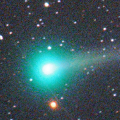
|
It brightened up to 5.6 mag in early December (Dec. 9, Marco Goiato). Now it is not observable. It will appear in the morning sky again in April. But then it will be fainter than 15 mag.
Date(TT) R.A. (2000) Decl. Delta r Elong. m1 Best Time(A, h)
Dec. 19 17 19.18 -20 44.1 1.392 0.434 7 6.1 5:32 (288,-11)
Dec. 26 18 13.96 -18 6.5 1.503 0.532 5 7.1 5:35 (282,-14)
|
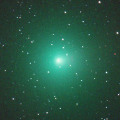
|
It brightened up to 7.3 mag in November (Nov. 7, Marco Goiato). Now it is fading. But it is bright as 9.7 mag still now (Dec. 12, Mitsunori Tsumura). In the Northern Hemisphere, it stays observable in excellent condition for a long time. In the Southern Hemisphere, it stays locating extremely low after this.
Date(TT) R.A. (2000) Decl. Delta r Elong. m1 Best Time(A, h)
Dec. 19 5 16.36 40 13.2 0.532 1.498 161 9.2 23:23 (180, 84)
Dec. 26 5 14.29 43 29.3 0.603 1.553 155 9.7 22:53 (180, 81)
|
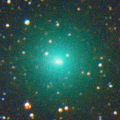
|
It brightened up to 8.2 mag in autumn (Oct. 13, Chris Wyatt). Now it is fading. But it is bright as 10.0 mag still now (Dec. 9, Chris Wyatt). It stays observable in the evening low sky while it will be getting fainter gradually, until early January in the Southern Hemisphere, or late February in the Northern Hemisphere.
Date(TT) R.A. (2000) Decl. Delta r Elong. m1 Best Time(A, h)
Dec. 19 21 37.41 -17 37.8 2.000 1.624 53 10.9 18:22 ( 42, 26)
Dec. 26 21 57.91 -15 44.1 2.082 1.664 51 11.2 18:25 ( 45, 26)
|
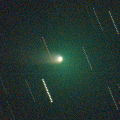
|
Brightened rapidly. Now it is very bright as 10.5 mag (Dec. 14, Seiichi Yoshida). In the Northern Hemisphere, it stays observable in good condition for a long time. In the Southern Hemisphere, it will be extremely low after January.
Date(TT) R.A. (2000) Decl. Delta r Elong. m1 Best Time(A, h)
Dec. 19 0 39.39 19 57.2 0.700 1.381 109 11.1 18:47 ( 0, 75)
Dec. 26 0 56.04 23 37.4 0.754 1.404 107 11.6 18:36 ( 0, 79)
|
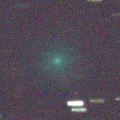
|
It brightened very rapidly in early December. Now it is very bright as 11.8 mag (Dec. 14, Alan Hale). In addition, Michael Jager observed two more components of 17.5-18.0 mag. It stays observable for a long time in this apparition.
Date(TT) R.A. (2000) Decl. Delta r Elong. m1 Best Time(A, h)
Dec. 19 21 26.23 -9 7.6 0.728 0.809 53 11.6 18:22 ( 50, 31)
Dec. 26 22 5.99 -8 42.7 0.659 0.823 56 11.2 18:25 ( 48, 33)
|

|
Now it is bright as 11.9 mag (Nov. 14, Ken Harikae). It stays 12 mag until March. In the Southern Hemisphere, it stays observable in good condition after this. In the Northern Hemisphere, it will be observable in the extremely low sky only from November to December.
Date(TT) R.A. (2000) Decl. Delta r Elong. m1 Best Time(A, h)
Dec. 19 14 15.90 -32 58.2 2.229 1.720 47 11.7 5:32 (324, 11)
Dec. 26 14 23.54 -37 50.6 2.160 1.734 51 11.7 5:35 (331, 9)
|
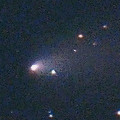
|
First return of a new periodic comet which brightened up to 13 mag in 2009. Now it is bright as 12.4 mag (Dec. 14, Seiichi Yoshida). It stays 12 mag until January, and it is observable in excellent condition.
Date(TT) R.A. (2000) Decl. Delta r Elong. m1 Best Time(A, h)
Dec. 19 4 33.44 -7 2.4 0.376 1.309 144 12.2 22:40 ( 0, 48)
Dec. 26 4 39.32 -3 33.9 0.376 1.306 143 12.2 22:18 ( 0, 52)
|
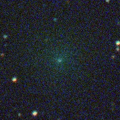
|
Brightened rapidly. Now it is very bright as 12 mag (Dec. 14, Michael Mattiazzo). It will approach to Earth down to 0.46 a.u. in April, and it is expected to brighten up to 9 mag and to be observable in excellent condition.
Date(TT) R.A. (2000) Decl. Delta r Elong. m1 Best Time(A, h)
Dec. 19 21 28.91 -20 17.0 1.982 1.563 51 12.9 18:22 ( 42, 22)
Dec. 26 21 21.89 -19 34.5 2.053 1.485 42 12.8 18:25 ( 50, 17)
|
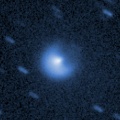
|
Now it is 13.1 mag (Dec. 13, Toshihiko Ikemura, Hirohisa Sato).
Date(TT) R.A. (2000) Decl. Delta r Elong. m1 Best Time(A, h)
Dec. 19 2 15.81 24 52.5 5.141 5.844 131 13.3 20:22 ( 0, 80)
Dec. 26 2 14.88 24 36.0 5.230 5.846 124 13.3 19:54 ( 0, 80)
|
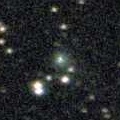
|
Now it is 13.2 mag (Dec. 12, Toshihiko Ikemura, Hirohisa Sato). It will brighten up to 11 mag in winter in 2022. In the Northern Hemisphere, it stays observable in good condition for a long time. In the Southern Hemisphere, it is not observable until 2021 November.
Date(TT) R.A. (2000) Decl. Delta r Elong. m1 Best Time(A, h)
Dec. 19 0 1.58 58 40.6 4.483 4.930 111 14.1 18:22 (176, 66)
Dec. 26 0 6.24 57 44.9 4.496 4.890 107 14.0 18:25 (167, 66)
|

|
It had been observed as 8-9 mag for a long time in 2020. Now it is not observable. It will appear in the morning sky at 14.5 mag.
Date(TT) R.A. (2000) Decl. Delta r Elong. m1 Best Time(A, h)
Dec. 19 16 36.76 -24 22.6 4.191 3.259 16 14.2 5:32 (296, -5)
Dec. 26 16 44.93 -25 25.4 4.221 3.326 21 14.3 5:35 (300, -2)
|
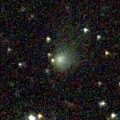
|
Now it is 14.3 mag (Nov. 12, Toshihiko Ikemura, Hirohisa Sato). It is expected to be observable at 5-6 mag for a long time from 2022 to 2023. In the Northern Hemisphere, it is not observable at the high light from 2022 summer to 2023 summer. In the Southern Hemisphere, it is not observable now. But it will be observable in good condition at the high light.
Date(TT) R.A. (2000) Decl. Delta r Elong. m1 Best Time(A, h)
Dec. 19 17 44.66 35 27.5 8.001 7.539 58 14.3 5:32 (237, 16)
Dec. 26 17 49.00 35 14.5 7.943 7.485 59 14.2 5:35 (241, 20)
|
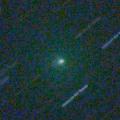
|
Brightened very rapidly. Now it is very bright as 12.5 mag (Dec. 7, Michael Jager). It is observable in excellent condition. But it seems to fade out very rapidly after this.
Date(TT) R.A. (2000) Decl. Delta r Elong. m1 Best Time(A, h)
Dec. 19 1 40.55 7 32.5 0.644 1.411 118 14.3 19:48 ( 0, 63)
Dec. 26 1 59.93 6 45.5 0.691 1.427 115 14.6 19:40 ( 0, 62)
|
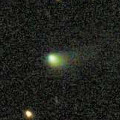
|
It stays 13-14 mag from 2020 to 2021. It is not observable until January.
Date(TT) R.A. (2000) Decl. Delta r Elong. m1 Best Time(A, h)
Dec. 19 16 24.72 -17 42.2 3.789 2.886 20 14.3 5:32 (293, 1)
Dec. 26 16 36.57 -18 25.4 3.748 2.882 24 14.3 5:35 (296, 4)
|
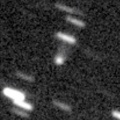
|
Now it is 14.8 mag (May 14, Toshiyuki Takahashi). It will brighten up to 13 mag in 2021. In the Southern Hemisphere, it becomes too low to observe temporarily from mid October to mid December. In the Northern Hemisphere, it is not observable until July in 2022.
Date(TT) R.A. (2000) Decl. Delta r Elong. m1 Best Time(A, h)
Dec. 19 15 59.89 -44 4.4 4.785 3.967 30 14.4 5:32 (317,-11)
Dec. 26 16 10.29 -45 23.4 4.716 3.941 34 14.3 5:35 (320, -9)
|
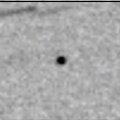
|
It will brighten up to 11.5 mag in spring. However, the condition is very bad in this apparition. It will appear in the morning low sky in March in the Southern Hemisphere, or in June in the Northern Hemisphere.
Date(TT) R.A. (2000) Decl. Delta r Elong. m1 Best Time(A, h)
Dec. 19 17 11.99 -17 31.8 2.677 1.718 10 15.0 5:32 (286, -8)
Dec. 26 17 32.42 -18 13.1 2.629 1.680 12 14.6 5:35 (288, -6)
|

|
It will approach to Sun down to 0.14 a.u. on Dec. 7, and will brighten up to 11 mag. But it is not observable at the high light.
Date(TT) R.A. (2000) Decl. Delta r Elong. m1 Best Time(A, h)
Dec. 19 19 8.31 -14 38.4 1.166 0.429 20 14.8 18:22 ( 70, 3)
Dec. 26 20 7.02 -9 10.3 1.216 0.603 29 15.6 18:25 ( 70, 12)
|
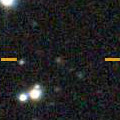
|
Now it is 16.0 mag (Dec. 7, Michael Jager). It will brighten up to 13.5 mag from winter to spring. In the Northern Hemisphere, it stays observable in excellent condition. In the Southern Hemisphere, it stays extremely low until spring.
Date(TT) R.A. (2000) Decl. Delta r Elong. m1 Best Time(A, h)
Dec. 19 23 47.38 36 41.6 1.282 1.791 103 15.1 18:22 (109, 84)
Dec. 26 23 59.56 34 56.6 1.268 1.727 99 14.9 18:25 ( 93, 81)
|

|
Now it is 14.9 mag (Oct. 10, Chris Wyatt). It will brighten up to 13.5 mag in spring. In the Southern Hemisphere, it stays observable in good condition for a long time, although it becomes unobservable temporarily in December. In the Northern Hemisphere, it is not observable until spring.
Date(TT) R.A. (2000) Decl. Delta r Elong. m1 Best Time(A, h)
Dec. 19 17 35.22 -43 20.1 4.447 3.540 20 15.2 5:32 (307,-25)
Dec. 26 17 38.49 -42 50.6 4.418 3.519 21 15.2 5:35 (309,-21)
|
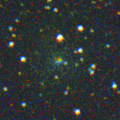
|
Now it is 16.1 mag (Nov. 14, Martin Masek). It is observable only until mid December in the Southern Hemisphere, or mid January in the Northern Hemisphere.
Date(TT) R.A. (2000) Decl. Delta r Elong. m1 Best Time(A, h)
Dec. 19 20 45.67 -17 56.7 2.768 2.137 41 15.3 18:22 ( 52, 18)
Dec. 26 20 59.70 -16 19.6 2.808 2.125 38 15.2 18:25 ( 56, 16)
|
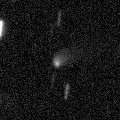
|
Now it is 15.0 mag (Nov. 15, Chris Wyatt). It stays 14-15 mag until 2021. In the Southern Hemisphere, it stays observable in good condition for a long time. In the Northern Hemisphere, it is not observable until June in 2021.
Date(TT) R.A. (2000) Decl. Delta r Elong. m1 Best Time(A, h)
Dec. 19 20 17.61 -58 33.9 5.051 4.397 44 15.2 18:22 ( 28,-16)
Dec. 26 20 31.09 -57 15.3 5.076 4.387 41 15.2 18:25 ( 30,-16)
|
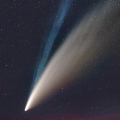
|
It approached to Sun down to 0.29 a.u. on July 3, and it brightened up to 0.6 mag (Alan Hale). Now it is fading. It has been already fainter than 15.0 mag (Oct. 12, Mitsunori Tsumura). Now it is not observable. It will appear in the morning sky at 16 mag.
Date(TT) R.A. (2000) Decl. Delta r Elong. m1 Best Time(A, h)
Dec. 19 16 18.52 -22 12.5 3.984 3.083 20 15.3 5:32 (297, 0)
Dec. 26 16 23.29 -22 44.8 4.023 3.175 26 15.5 5:35 (301, 4)
|

|
Now it is 14.4 mag (Dec. 12, Toshihiko Ikemura, Hirohisa Sato). In the Northern Hemisphere, it stays observable for a long time while it is getting fainter slowly. In the Southern Hemisphere, it will never be observable again.
Date(TT) R.A. (2000) Decl. Delta r Elong. m1 Best Time(A, h)
Dec. 19 16 11.80 59 43.6 4.858 4.880 85 15.4 5:32 (218, 39)
Dec. 26 16 17.98 59 50.6 4.882 4.926 86 15.5 5:35 (218, 42)
|
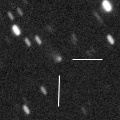
|
Now it is 15.9 mag (Nov. 10, Toshihiko Ikemura, Hirohisa Sato). It will stay at 14 mag for a long time from 2021 to 2022. In the Northern Hemisphere, it stays observable in good condition while brightening gradually, although it becomes unobservable temporarily in December. In the Southern Hemisphere, it is not observable until February.
Date(TT) R.A. (2000) Decl. Delta r Elong. m1 Best Time(A, h)
Dec. 19 17 54.31 6 4.0 6.390 5.555 29 15.5 18:22 ( 98, -1)
Dec. 26 17 57.76 5 29.7 6.368 5.532 29 15.4 5:35 (265, 2)
|
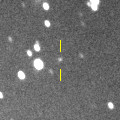
|
Now it is 15.5 mag (Nov. 12, Martin Masek). It is expected to brighten up to 13 mag in 2022. In 2020, it is observable in excellent condition in the Southern Hemisphere. In the Northern Hemisphere, it is observable from autumn to winter, but it locating extremely low.
Date(TT) R.A. (2000) Decl. Delta r Elong. m1 Best Time(A, h)
Dec. 19 8 30.64 -39 30.4 5.699 6.053 106 15.6 2:40 ( 0, 15)
Dec. 26 8 28.67 -39 58.6 5.610 6.015 109 15.5 2:10 ( 0, 15)
|
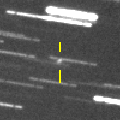
|
First return of a new periodic comet which brightened up to 17 mag in 2013. Now it is 16.6 mag (Dec. 12, Toshihiko Ikemura, Hirohisa Sato). It will brighten up to 16 mag and will be observable in good condition in winter. In the Southern Hemisphere, it locates low until December.
Date(TT) R.A. (2000) Decl. Delta r Elong. m1 Best Time(A, h)
Dec. 19 12 7.70 23 22.6 0.466 1.124 94 15.9 5:32 (318, 75)
Dec. 26 12 33.22 19 5.9 0.470 1.122 94 15.9 5:35 (329, 72)
|
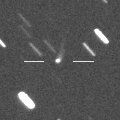
|
Now it is 16.3 mag (Nov. 9, Toshihiko Ikemura, Hirohisa Sato). It will brighten up to 14.5 mag from spring to summer in 2021. In the Southern Hemisphere, it stays observable in excellent condition for a long time. In the Northern Hemisphere, it is observable in good condition in 2020, however, it will be unobservable in 2021.
Date(TT) R.A. (2000) Decl. Delta r Elong. m1 Best Time(A, h)
Dec. 19 21 22.66 -33 14.8 3.519 2.949 47 15.9 18:22 ( 35, 11)
Dec. 26 21 27.07 -33 54.2 3.570 2.917 42 15.9 18:25 ( 40, 7)
|
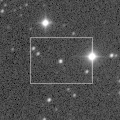
|
Now it is 15.7 mag (Dec. 8, Toshihiko Ikemura, Hirohisa Sato). It stays 15-16 mag until winter. In the Northern Hemisphere, it stays observable in good condition for a long time after this. In the Southern Hemisphere, it will be getting lower after this, and it will be unobservable in January.
Date(TT) R.A. (2000) Decl. Delta r Elong. m1 Best Time(A, h)
Dec. 19 23 10.11 -1 8.3 1.014 1.296 80 16.1 18:22 ( 26, 51)
Dec. 26 23 26.29 4 2.8 1.056 1.306 79 16.2 18:25 ( 35, 54)
|
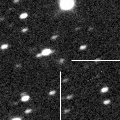
|
Now it is 16.4 mag (Nov. 9, Toshihiko Ikemura, Hirohisa Sato). It is observable at 16.5-17 mag from 2020 to 2021. In the Southern Hemisphere, it is not observable until summer in 2021
Date(TT) R.A. (2000) Decl. Delta r Elong. m1 Best Time(A, h)
Dec. 19 22 7.97 52 33.8 5.810 5.969 94 16.5 18:22 (138, 62)
Dec. 26 22 10.69 51 4.7 5.881 5.965 90 16.6 18:25 (132, 58)
|

|
First return of a new periodic comet which brightened up to 14-15 mag in 2006. Now it is 17.8 mag (Nov. 23, Toshihiko Ikemura, Hirohisa Sato). It is expected to brighten up to 15-16 mag from February to March, and it will be observable in good condition.
Date(TT) R.A. (2000) Decl. Delta r Elong. m1 Best Time(A, h)
Dec. 19 11 19.05 1 38.2 1.397 1.808 97 16.9 5:28 ( 0, 57)
Dec. 26 11 33.90 1 30.8 1.321 1.791 100 16.6 5:15 ( 0, 56)
|
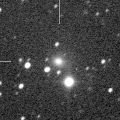
|
It brightened up to 13.5 mag in last winter (Dec. 6, 2019, Chris Wyatt). Now it is fading slowly. Now it is 17.0 mag (Dec. 13, Toshihiko Ikemura, Hirohisa Sato). In the Southern Hemisphere, it stays observable for a long time. It locates somewhat low in the Northern Hemisphere. Taras Prystavski found its fragmentation on Sept. 12.
Date(TT) R.A. (2000) Decl. Delta r Elong. m1 Best Time(A, h)
Dec. 19 1 16.59 -27 21.5 4.625 4.847 97 16.6 19:23 ( 0, 28)
Dec. 26 1 14.58 -25 52.6 4.764 4.889 91 16.7 18:54 ( 0, 29)
|
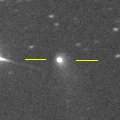
|
It brightened up to 13.8 mag in autumn in 2019 (Sept. 3, 2019, Chris Wyatt). Now it is fading slowly. It has already faded down to 17.2 mag (Dec. 8, Toshihiko Ikemura, Hirohisa Sato).
Date(TT) R.A. (2000) Decl. Delta r Elong. m1 Best Time(A, h)
Dec. 19 23 42.77 3 41.1 6.756 6.832 90 16.7 18:22 ( 15, 58)
Dec. 26 23 43.66 4 2.8 6.916 6.874 83 16.7 18:25 ( 29, 56)
|
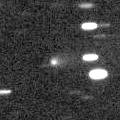
|
Now it is 16.9 mag (Dec. 10, Toshihiko Ikemura, Hirohisa Sato). It stays 16 mag until winter, and observable in good condition. It locates somewhat low in the Southern Hemisphere.
Date(TT) R.A. (2000) Decl. Delta r Elong. m1 Best Time(A, h)
Dec. 19 8 39.22 19 15.6 1.603 2.440 140 16.7 2:49 ( 0, 74)
Dec. 26 8 34.89 19 56.1 1.587 2.479 148 16.8 2:17 ( 0, 75)
|
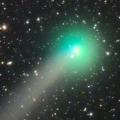
|
It brightened up to 6.0 mag in June (June 13, Marco Goiato). Now it is fading. It has already faded down to 15.5 mag (Nov. 18, Thomas Lehmann). In the Northern Hemisphere, it stays observable for a long time until it fades out. In the Southern Hemisphere, it will never be observable again.
Date(TT) R.A. (2000) Decl. Delta r Elong. m1 Best Time(A, h)
Dec. 19 19 5.11 25 26.1 3.399 2.903 52 16.7 18:22 (105, 24)
Dec. 26 19 17.51 26 3.3 3.498 2.985 51 16.9 18:25 (108, 21)
|
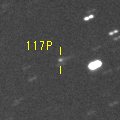
|
Now it is 16.1 mag (Nov. 13, Toshihiko Ikemura, Hirohisa Sato). It will brighten up to 13 mag in 2022. In 2021, it is observable at 15-16 mag in good condition.
Date(TT) R.A. (2000) Decl. Delta r Elong. m1 Best Time(A, h)
Dec. 19 13 18.78 -1 10.2 4.187 3.939 68 16.8 5:32 (317, 45)
Dec. 26 13 24.04 -1 36.5 4.071 3.924 74 16.7 5:35 (325, 48)
|
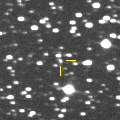
|
Now it is 16.6 mag (Nov. 9, Toshihiko Ikemura, Hirohisa Sato). It stays at 16-17 mag from 2020 to 2021. In the Northern Hemisphere, it stays observable in good condition for a long time. It is not observable in the Southern Hemisphere.
Date(TT) R.A. (2000) Decl. Delta r Elong. m1 Best Time(A, h)
Dec. 19 19 11.24 29 39.2 9.333 8.831 56 16.8 18:22 (109, 27)
Dec. 26 19 14.12 29 53.1 9.359 8.829 54 16.8 18:25 (112, 22)
|
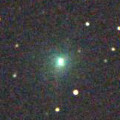
|
It approached to Sun down to 0.34 a.u. on Oct. 20. Then the nucleus was disintegrated. After the perihelion passage, it was observed at 12.5 mag (Oct. 28, Michael Jager). Now only the remnant tail is visible. In the Northern Hemisphere, it stays observable while the comet will be fading rapidly. In the Southern Hemipshere, it will never be observable again.
Date(TT) R.A. (2000) Decl. Delta r Elong. m1 Best Time(A, h)
Dec. 19 15 21.91 6 7.6 1.908 1.419 46 16.9 5:32 (283, 28)
Dec. 26 15 30.17 5 52.2 1.967 1.542 50 17.3 5:35 (287, 32)
|
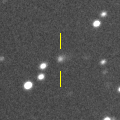
|
It brightened up to 16.1 mag in last winter (Mar. 18, Toshihiko Ikemura, Hirohisa Sato). In 2021, it stays observable at 17 mag in good condition until summer.
Date(TT) R.A. (2000) Decl. Delta r Elong. m1 Best Time(A, h)
Dec. 19 13 1.04 -19 52.4 7.092 6.753 66 17.0 5:32 (333, 30)
Dec. 26 13 4.23 -20 4.6 6.998 6.764 72 17.0 5:35 (340, 32)
|
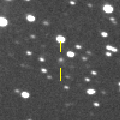
|
Now it is 16.0 mag (Dec. 7, Michael Jager). It is observable in good condition in the Northern Hemisphere. It locates somewhat low in the Southern Hemisphere.
Date(TT) R.A. (2000) Decl. Delta r Elong. m1 Best Time(A, h)
Dec. 19 2 21.93 30 59.0 1.088 1.907 133 17.1 20:29 ( 0, 86)
Dec. 26 2 28.06 29 18.1 1.131 1.905 128 17.1 20:08 ( 0, 84)
|
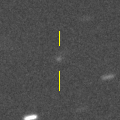
|
Now it is 16.7 mag (Dec. 12, Toshihiko Ikemura, Hirohisa Sato). It is expected to brighten up to 14 mag from spring to summer, and it stays observable in good condition for a long time. In the Southern Hemisphere, it is not observable until late December.
Date(TT) R.A. (2000) Decl. Delta r Elong. m1 Best Time(A, h)
Dec. 19 12 53.13 25 13.0 3.015 3.112 86 17.3 5:32 (291, 68)
Dec. 26 13 2.48 25 18.9 2.880 3.056 90 17.1 5:35 (299, 72)
|
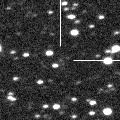
|
Now it is 17.2 mag (Oct. 25, A. Mickleburgh). It stays 15-16 mag for a long time from 2021 spring to 2022 spring. It stays observable for a long time in the Northern Hemisphere. In the Southern Hemipsphere, it is not observable until the end of 2021.
Date(TT) R.A. (2000) Decl. Delta r Elong. m1 Best Time(A, h)
Dec. 19 19 32.63 43 37.1 4.026 3.824 71 17.3 18:22 (122, 36)
Dec. 26 19 35.90 43 34.5 4.019 3.784 69 17.2 18:25 (124, 32)
|
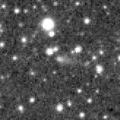
|
First return of a new periodic comet which brightened up to 17.5 mag in 2012. Now it is 17.9 mag (Dec. 9, Toshihiko Ikemura, Hirohisa Sato). It stays observable at 17 mag in good condition from summer to winter. It locates low in the Southern Hemisphere.
Date(TT) R.A. (2000) Decl. Delta r Elong. m1 Best Time(A, h)
Dec. 19 4 38.40 38 32.2 1.672 2.614 158 17.4 22:44 (180, 86)
Dec. 26 4 33.01 38 11.9 1.723 2.637 152 17.5 22:12 (180, 87)
|
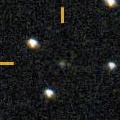
|
Now it is 16.8 mag (Dec. 7, Toshihiko Ikemura, Hirohisa Sato). It is observable at 17-18 mag for a long time from late 2019 to early 2021. It will fade out before it passes the perihelion.
Date(TT) R.A. (2000) Decl. Delta r Elong. m1 Best Time(A, h)
Dec. 19 5 40.30 17 51.9 3.503 4.483 174 17.4 23:46 ( 0, 73)
Dec. 26 5 35.98 18 7.2 3.505 4.473 168 17.4 23:14 ( 0, 73)
|

|
It stays observable at 16-17 mag from 2021 to 2022.
Date(TT) R.A. (2000) Decl. Delta r Elong. m1 Best Time(A, h)
Dec. 19 14 6.90 -27 59.2 5.798 5.214 49 17.5 5:32 (323, 16)
Dec. 26 14 11.45 -27 50.9 5.686 5.191 55 17.4 5:35 (328, 19)
|

|
Now it is 17.9 mag (Nov. 19, Giuseppe Pappa). It is expected to brighten up to 12 mag in 2022. In the Southern Hemisphere, it stays observable in good condition for a long time. In the Northern Hemisphere, it is not observable until 2022.
Date(TT) R.A. (2000) Decl. Delta r Elong. m1 Best Time(A, h)
Dec. 19 3 16.06 -50 23.0 6.244 6.470 98 17.6 21:21 ( 0, 5)
Dec. 26 3 9.11 -50 10.5 6.255 6.421 95 17.6 20:47 ( 0, 5)
|
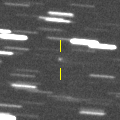
|
Now it is 17.3 mag (Dec. 12, Toshihiko Ikemura, Hirohisa Sato). It stays observable at 17-18 mag in good condition until winter.
Date(TT) R.A. (2000) Decl. Delta r Elong. m1 Best Time(A, h)
Dec. 19 7 49.10 21 19.3 1.371 2.287 151 17.8 1:59 ( 0, 76)
Dec. 26 7 43.78 22 16.1 1.368 2.318 160 17.8 1:26 ( 0, 77)
|
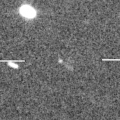
|
Now it is 18.2 mag (Nov. 23, Toshihiko Ikemura, Hirohisa Sato). It is expected to brighten up to 10 mag in 2023. In the Northern Hemisphere, it stays observable in good condition until 2023 autumn. In the Southern Hemipshere, it stays hardly observable for a while. But it becomes observable in good condition after 2023 summer.
Date(TT) R.A. (2000) Decl. Delta r Elong. m1 Best Time(A, h)
Dec. 19 13 18.38 25 48.0 8.457 8.372 81 17.9 5:32 (283, 64)
Dec. 26 13 19.41 26 19.6 8.301 8.322 87 17.8 5:35 (290, 70)
|
|
![]()
 C/2020 N1 ( PanSTARRS )
C/2020 N1 ( PanSTARRS ) C/2020 J1 ( SONEAR )
C/2020 J1 ( SONEAR ) 17P/Holmes
17P/Holmes C/2020 F5 ( MASTER )
C/2020 F5 ( MASTER ) C/2020 F3 ( NEOWISE )
C/2020 F3 ( NEOWISE ) C/2018 N2 ( ASASSN )
C/2018 N2 ( ASASSN ) C/2018 U1 ( Lemmon )
C/2018 U1 ( Lemmon ) C/2019 T4 ( ATLAS )
C/2019 T4 ( ATLAS ) 405P/2020 U1 ( Lemmon )
405P/2020 U1 ( Lemmon ) C/2019 T2 ( Lemmon )
C/2019 T2 ( Lemmon ) 162P/Siding Spring
162P/Siding Spring C/2019 T3 ( ATLAS )
C/2019 T3 ( ATLAS ) 409P/2020 V1 ( LONEOS-Hill )
409P/2020 V1 ( LONEOS-Hill ) C/2018 F4 ( PanSTARRS )
C/2018 F4 ( PanSTARRS ) C/2017 B3 ( LINEAR )
C/2017 B3 ( LINEAR ) 84P/Giclas
84P/Giclas C/2019 U6 ( Lemmon )
C/2019 U6 ( Lemmon ) 117P/Helin-Roman-Alu 1
117P/Helin-Roman-Alu 1 C/2019 O3 ( Palomar )
C/2019 O3 ( Palomar ) C/2020 P1 ( NEOWISE )
C/2020 P1 ( NEOWISE ) C/2019 C1 ( ATLAS )
C/2019 C1 ( ATLAS ) 277P/LINEAR
277P/LINEAR C/2020 T2 ( Palomar )
C/2020 T2 ( Palomar ) C/2020 M5 ( ATLAS )
C/2020 M5 ( ATLAS ) 397P/2020 M2 ( Lemmon )
397P/2020 M2 ( Lemmon ) 173P/Mueller 5
173P/Mueller 5 C/2020 H6 ( ATLAS )
C/2020 H6 ( ATLAS ) C/2020 R7 ( ATLAS )
C/2020 R7 ( ATLAS ) 178P/Hug-Bell
178P/Hug-Bell C/2020 V2 ( ZTF )
C/2020 V2 ( ZTF )![]()









































